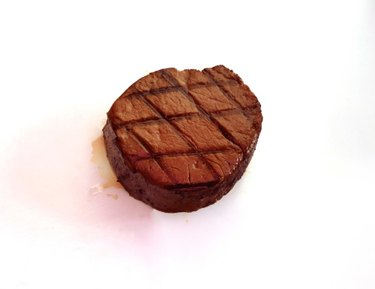
Roughly 30 percent of adults in the United States experienced joint pain or stiffness in 2006, according to a National Health Interview Survey. The most common cause is arthritis -- the term for chronic joint inflammation. Although particular foods are not known to cause joint problems, your overall diet may contribute. If you suspect a correlation between meat and your joint symptoms, or if your symptoms are severe, seek guidance from your doctor.
Immediate Causes
Video of the Day
If your joint pain flares up shortly after eating red meat, you may have a painful form of arthritis called gout. After eating foods containing purines, which occur naturally in most foods, your body produces a waste product called uric acid. Gout occurs when your uric acid levels become excessive and form crystals that gather in a single joint. Meat contains more purines than most other foods. Although dietary factors are not the main cause of gout for most people, according to Johns Hopkins Medicine, or JHM, purine-rich foods, including meats, may trigger or exacerbate your symptoms. Having a genetic predisposition for gout increases your risk significantly. Gout symptoms often arise suddenly, in episodes known as gout attacks. They can affect various joints, but the joint in your big toe is the most common.
Video of the Day
Gradual Causes
Meat contains omega-6 fatty acids, which can increase inflammation, particularly when you consume too few omega-3 fatty acids, which are prevalent in cold-water fish, flax seeds and walnuts, according to Arthritis Today. The more meat you consume, the less room you have in your diet for beneficial foods and the greater your risk becomes for joint inflammation, pain and stiffness. Gout symptoms can also form gradually as your intake of purine-rich foods increases. If your joints have been injured, it's possible that eating inflammatory foods, such as fatty meats, will worsen your symptoms or slow the healing process.
Other Problem Foods
The unhealthy fats in meat are generally considered more problematic than the meat itself when it comes to joint pain. If your meal or overall diet contains other sources of unhealthy fats, they may also contribute to your symptoms. Non-meat saturated fat sources include egg yolks, fried foods and high-fat dairy products, such as whole milk, cheese, ice cream and butter. Trans-fatty acids can also trigger inflammation, according to the Linus Pauling Institute at Oregon State University. Common sources include stick margarine, shortening and commercially prepared cookies, cakes, crackers, frosting, chips and pastries. Other purine-rich foods that may contribute to gout pain include sardines, anchovies and yeast, which is prevalent in bread.
Suggestions
To lower your uric acid levels and guard against gout, choose plant-based protein sources, such as beans, lentils and tofu, instead of meat most often. Low-fat dairy products may also help minimize gout symptoms, according to JHM. Plant-based protein sources also provide saturated fat-free alternatives to fatty meats, whether you have gout or inflammation related to other conditions. Meats low in saturated fat include skinless-white meat poultry, extra-lean ground beef and lean pork. For heightened benefits, prepare foods using heart-healthy cooking techniques, such as baking, broiling, steaming and grilling with olive oil instead of frying.
- Centers for Disease Control and Prevention: Percentage of Adults* Reporting Joint Pain or Stiffness,† --- National Health Interview Survey, United States, 2006
- Johns Hopkins Medicine: Gout and Diet
- Arthritis Today: Diets for Arthritis: Eat to Beat Joint Inflammation
- Linus Pauling Institute: Two Faces of Inflammation
Is this an emergency? If you are experiencing serious medical symptoms, please see the National Library of Medicine’s list of signs you need emergency medical attention or call 911.